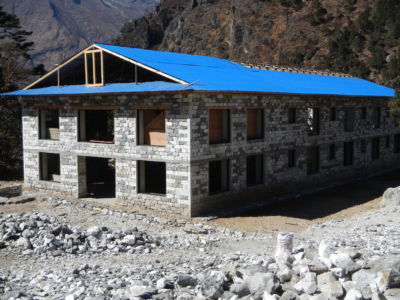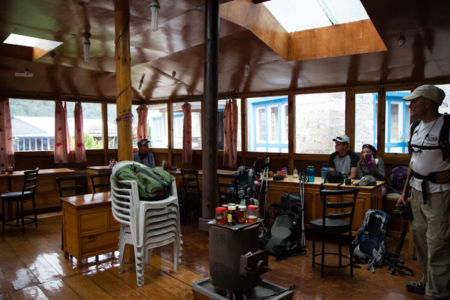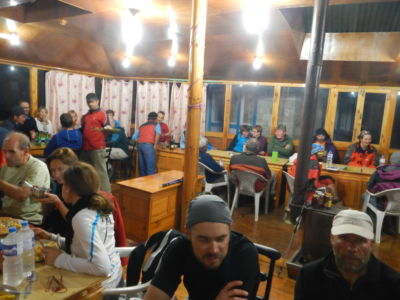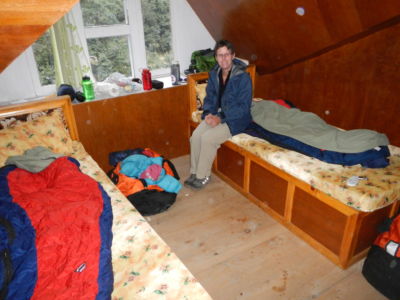The Diapers and Depends Gang
After planning and anticipating for close to a year, having traveled from various places in the U.S. to San Francisco in order to fly half-way around the world, having survived both the traffic in Kathmandu and the flight into Lukla…we were more than ready to finally begin hiking.

Dave, Joel, Dan, Cailie, Finjo, Andrew, Rob, Allison, Sharon, Nima
The Route
Given that our group was composed of people who love mountains and high places, we specifically chose a three week trip that would take us throughout the rugged area south and west of Mt Everest. All trekkers to the Everest region of Nepal start by flying into Lukla, and after two days of walking, arrive in Namche. The most popular trip from this historic village appeared to be the out and back trip to Everest Base Camp (EBC). Our trip would avoid that main trail and take us off significantly the beaten path. As we completed our meandering clockwise journey around the region, we would cross over two high passes – Renjo Pass (17,585′) and Chola Pass (17,782′). We would take a side trip north to Everest base camp, with a chance to climb Kala Patthar (18,192). Finally we would take another side trip to attempt to climb a mountain tucked into the shadow of Everest known as Island Peak (aka Imja Tse – 20,305′). In all, we would spend close to two week above 14,000′.

Trekking…in general
There are several options available for anyone interested in trekking in the Himalaya. A few folks found their way to Lukla by themselves. Hiking with backpacks, they either camped or made their own arrangements each night to stay in one of the many tea houses. As an alternative, Philip and Michele hired a guide and porter through Mountain Monarch to help with logistics, but followed their own itinerary. Others went with western guide companies. They had porters carry their gear, but generally had western guides and food. To a large degree, it seemed that while they passed through the region they remained separate from the local scene. Our choice was to go with a package deal from Mountain Monarch. We had a full complement of guides and porters. With the exception of base camp at Imja Tse, we ate and slept in tea houses along the way. We also followed a defined agenda, with our path, distances, rest days, etc for the most part predetermined. While we totally enjoyed our trip as it unfolded, it also would have been nice to travel using our famous “no plan” plan. If we were to do it again, we would probably follow the example of Philip and Michele. There was definitely value in having local knowledge and expertise, especially just getting through the airport to Lukla. They enjoyed a bit more freedom in deciding when and where they wanted to go.
Lodging
Trekking has become big business in the Khumbu Himal. In many villages, it appears that almost the entire economy is given over to accommodating trekkers. We were part of that. We took all our meals, and spent most nights in tea houses. In general, tea houses all have a common room, heated by a yak dung stove, where folks could hang out and where meals are served. Sleeping areas are unheated double rooms with simple platforms topped with a foam pad. Typically there is a single bathroom – dubbed the squatter – that is shared by all. While they all had similar features, that is not to say they were all the same. Some were a bit more …’polished’ than others. Some had lights, some had none. Some had carpet in the bedrooms, some had dirt floors covered with a bit of astro turf. Given the remote nature of our trip and the cold weather, even the most rustic tea house offered a relatively comfortable place to call home at the end of each day.




Food
The food was…a bit of a challenge for us. Locals typically ate a vegetable and rice dish known as dal bhat and seemed quite content. Several times our guides turned up their noses at offers to share our western food choices. Dal bhat was fine, and we all tried it at our first group meal. Personally I would have had a hard time eating that twice a day for three weeks. The tea houses tried hard to tailor their menus to the tastes of an international population of trekkers. Given the difficulty of getting supplies to this remote region, and the unfamiliar nature of many foreign food preferences, they were actually remarkably successful. Having said that, there were also some spectacular failures. The “spaghetti” with “home made noodles” was instantly renamed “tapeworms in blood” both for the looks and taste. Since wasting food in a poor country was almost unforgivably thoughtless, and after trying several optimistically named menu items, we all learned to stick to simple, safe fare such as hard fried eggs, and various potato dishes. We recognized that our difficulty with the food had more to do with our taste and expectations than what was offered. Having said that, we all struggled to get enough calories to fuel our hike and keep us warm in the constant cold. We also agreed that the word ‘explosive’ should never, under any circumstances, ever apply to certain bodily functions. We all agreed based on experience. Enough said. We laugh about it now, but at the time it was a real challenge.
The Trail
I believe Joel and Allison calculated after the fact, that we traveled some 160 miles during our three week trek. The trail varied from finely laid stone paths to ‘barely-there-path-wannabe’ pathways. We varied in elevation from 8,500′ a day out of Lukla to almost 18,000′ crossing over the passes. We walked in shorts for a day or two, and endured horizontal snow and well below freezing temps. We passed through humble villages and bustling trekker hot spots. We visited monasteries and met young monks texting on smartphones shortly after chanting words from ancient texts. We were treated to stunning mountain vistas while walking in the footsteps of generations of Tibetan traders and the earliest mountaineers. It was all exactly what we hoped for in a trip to Nepal.
Next time: A picture speaks a thousand words. I’ll be posting some of the most dramatic pictures from our time in Nepal. Sign up below for email notification.






















Loved the description of your trip and the photos!